I had heard about DNA tests as a genealogical tool for many years but costs were quite high and I was not convinced of their value to my research or for wider Caribbean genealogical research.
However, because of documentaries such as BBCs Motherland in 2003 Caribbean genealogists increasingly asked me if DNA tests would be useful for their research and help them reconnect with their African ancestors; I added several slides on DNA to my talks.
As the price came down I thought about taking a test – so that I could understand what was involved and if the results could actually help someone to extend their family tree or link them to their ancestral home. I was also curious if such tests would help answer these three questions:
- I do not know where my Grannum / Cranham ancestors came from and so maybe these tests would help to narrow down place of origin
- Maybe I would find a match with someone in Europe which would help me to continue my research
- My family had lived in Barbados for over 250 years. Was I mixed-race?
At the Who Do You Think You Are? Live exhibition in February 2009 I took the plunge and took a DNA test with Family Tree DNA (FTDNA). I started off with the Y-chromosome test with 67 markers. Y-chromosomes are passed from father to son and so reveal the deep ancestry of my paternal side. When I got the results back I was rather underwhelmed as I had a sheet with lots of numbers on it which didn’t mean anything to me. FTDNA has function to compare your results against other testers and the more markers someone matches you the closer you are genetically – it compares matches at 67, 37 and 25 markers; there is a 12 marker match but that is too vague to have any value. So far there haven’t been any matches at these higher levels.
Since then I have upgraded my results to include further in-depth YDNA tests, mitochondrial DNA tests (mtDNA my maternal side which is passed from mother to her children) and an autosomal test (family finder) which looks at my overall genetic admixture and plot ethnic makeup and can help to match close cousins (within the last 5 generations).
My results are
- Y-DNA (paternal side) = R1b1a2a1ab4 (now shortened to R-L21). Haplogroup R1b is the dominant group in Western Europe and R-L21 is most common in England and Ireland
- mtDNA (maternal side) = H33. Haplogroup H is the most common group in Europe
- Admixture = 87.33% Western Europe and 12.67% Europe (Mediterranean and Scandinavia)
These results have not helped me to focus the direction of any future research but they do answer my third question: I am European.
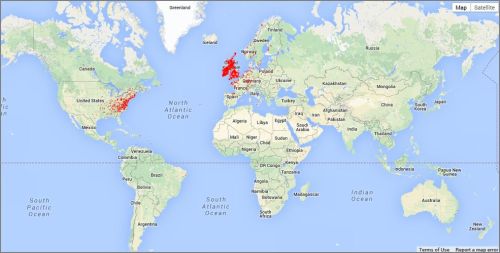
Location of earliest known male ancestor of people tested by Family Tree DNA with the haplogroup R-L21. My red dot is on Barbados.
In 2011 I set up the Grannum DNA project on FTDNA for Grannums to share their results; to date there is only one member – me!
I also uploaded my results to a number of other genetic genealogy websites to find matches. I have only had one ‘close’ match with 31 out of 33 markers on Genetree (which has now closed). This is also the only Grannum match I have found. The tester was from Panama and his grandfather Arnold Grannum came from Barbados. I was aware of Arnold from US census records where he is recorded as African. This put me in a bit of a quandary as I wasn’t sure if I should contact the tester. I know most of my extended family at this period (early 1900s) and so our common ancestor would be earlier which brings us into the period of slavery. I have since been in contact with him and some of his family – but that is for another tale.
In November 2013 I was contacted by an administrator of the FTDNA R1b-CTS4466 Plus Project who are trying to 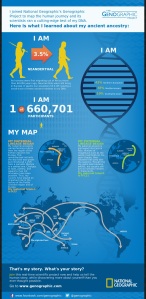 understand the origins of the Irish Type II haplotype. They asked if I would undertake further tests or maybe have the National Geographic Geno 2.0 test. There was a sale on at the time and so I sent for the kit as it might reveal new information. More interestingly their test also showed if you have Neanderthal or Denisovan DNA as scientists now believe that early Homo Sapiens mixed with these earlier hominids.
understand the origins of the Irish Type II haplotype. They asked if I would undertake further tests or maybe have the National Geographic Geno 2.0 test. There was a sale on at the time and so I sent for the kit as it might reveal new information. More interestingly their test also showed if you have Neanderthal or Denisovan DNA as scientists now believe that early Homo Sapiens mixed with these earlier hominids.
The results are posted online and I logged on a few weeks ago and my tests were complete.
The information reinforced my paternal and maternal haplogroups (R-L21 and H33 respectively) – and gave me some nice heat maps showing current populations for these haplogroups.
However, my admixture is different to that posted by FTDNA: 43% Northern European, 38% Mediterranean and 19% Southwest Asian. I am also apparently 3.5% Neanderthaland 3.6% Denisovan – they say that the Denisovan test is experimental and may change – so for now I am 92.9% human.
I was also able to upload my results to my FTDNA profile and shortly afterwards the administrator of the R1b-CTS4466 Plus Project contacted me to say that my results did not match their requirements and removed me from their project. So now I know that I don’t have the Irish Type II haplotype.
These results might be interesting and help scientists to better understand human evolution and migration but I am still not sure how they will help my family history or with Caribbean genealogy but may be when I can connect with others the value will become apparent.
If there are any Grannums or Cranhams who want to know more please contact me.
Update (29 May 2014)
On 5 May 2014 FTDNA released their Family Finder upgrade My Origins. It provide a more detailed breakdown of the autosomal results. It doesn’t include Neanderthal or Denisovan results but now I am 96% European (broken down into 77% European Coastal Islands, 15% European Northlands and 4% North Mediterranean Basin clusters) and 3% Middle Eastern (Eastern Afroasiastic). For more information about these clusters.
At about the same time there was an annoucement of a ground-breaking DNA tool – the Geographic Population Structure (GPS) – which suggests it is possible to identify a single point of origin for your ancestors. I was curious by this and visited Prosapia Genetics and uploaded the required data. There is a cost to have the dna tested. It then dawned on me that this uses your autosomal dna – a mixture of all your ancestors’ dna – and unless they all originated from the same spot it is not possible to isolate a single point of origin.
I am happy to be convinced that it will be money well spent.

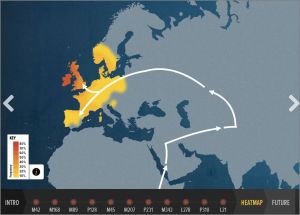
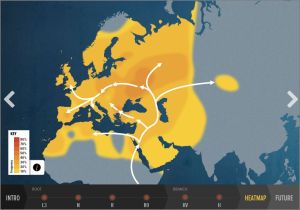
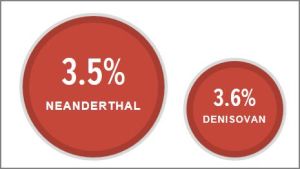
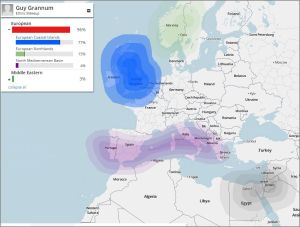
I got 3.1% Neanderthal through 23andMe.com. They don’t mention any other, so I guess I’m 96.9% modern human (homo sapiens?).
Jim, I don’t know if all companies look for Denisovan DNA but I’d take any results with a pinch of salt since FTDNA say theirs is experimental – read “fun” – and so few specimans have been found.
Hi Guy. My father is a Grannum from Barbados that I know had emailed you a few years ago. I’ve bought him the Geno 2.0 kit and will be mailing the swabs for testing tomorrow. As soon as I get the results I will let you know. I guess that will be sometime in August/September.
I’ve only just started reading about these DNA tests so this might not be feasible – Have you tried finding men in Britain that have the same markers as yourself – and figure out where their family was 250 years ago? That is – can you find out where in Britain your ancestor probably came from? And then try to figure out how the Grannum name was ‘created’?
Hi Pamela – I remember. Steven is your father? And you’re descended from Nathaniel & Elizabeth nee Jemmott.
It will be interesting to see the results. You can transfer the Geno results to Family Tree DNA and then we might be able to compare. I don’t know if there is an additional cost. I’ll find out.
So far I have only one close match – and I am hoping that as the prices come down more will be tempted to have their DNA tested and so I may get a link in the UK.
Yes – that is him. 🙂 He spends the summer away so isn’t near a computer. I will upload the results to Family Tree DNA once I get them. cheers
Hi Guy;
I have my father’s results from the Geno 2.0 project:
Y-DNA R-L21
mtDNA L2a1a1
Neandrathal 1.1%, Denovisan:0.9%
Northern Europe 38%, Mediterreanean:30%, Sub-Saharan African:17% NW Asian:14%
I did a transfer of the results to FamilyTreeDNA and joined your Grannum Surname Project. My understanding is that you can read the specific YDNA test results on that site as the Surname Project Administrator. My Dad is still at their cottage, not near a computer but he did say go ahead and share with you the info. So if I need to send you the raw file let me know :). His ID on FamilyTree is Steven Grannum – N128749
At the moment, the contact info is mine – Once he gets back to his computer we will change all the info to his email address etc. So if you send a mail on the FamilyDNA site it will go to me for the next 2-3 weeks. I did phone my Dad with th results and he was surprised when I explained what the L2a1a1 meant – but he is happy because he gets him some more info to trace some of his mother’s family.
Anyway – I hope that is of interest.
cheers
Pamela
.
Pamela, I’ve seen your father’s details – and he is a member of the project but he isn’t showing on the project page and I’m not sure why. I’ll contact you offline.
Pingback: My genes update | Caribbean Roots
Pingback: DNA: which test? | Caribbean Roots